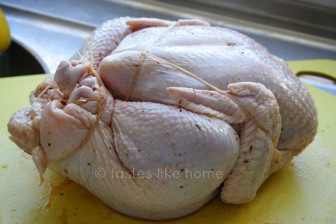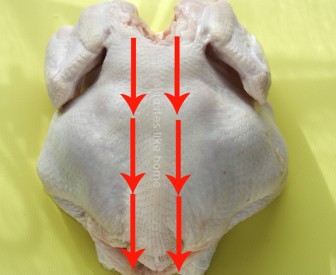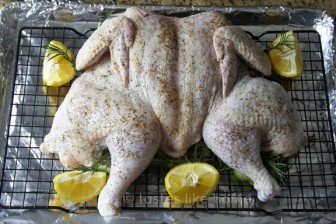Hi Everyone, This week we begin a 2-part series on roast chicken.
There are many ways to cook a chicken but roasting a chicken whole is one of the best ways to enjoy this famous bird. It’s a feast for the eyes and the belly! However, for many people, the thought of cooking a chicken whole is downright intimidating, a task fraught with many moments of confusion and doubt.
When it comes to roast chicken, here are some things that can come to mind: dry meat, flavourless meat… sure it looks good but how does it taste? Cooking questions ensue: how will I know when the chicken is done? How do I season a whole chicken so that it has taste? At what temperature should I cook the chicken? How do I test for doneness etc.?
 Other perplexing issues that arise due to the many points of view on how to roast a chicken include: trussing (tying the chicken up), should the cavity be stuffed, how to cook the chicken so that the breast meat stays moist, would cooking be easier if the chicken is butterflied/spatchcock (removal of the spine and breastbone)?
Other perplexing issues that arise due to the many points of view on how to roast a chicken include: trussing (tying the chicken up), should the cavity be stuffed, how to cook the chicken so that the breast meat stays moist, would cooking be easier if the chicken is butterflied/spatchcock (removal of the spine and breastbone)?
And then of course, facing reality – we also live in a time when many people do not necessarily want to know or genuinely do not know where their food comes from, so asking some of them to handle a whole chicken could easily make them a contestant for Fear Factor.
When I first heard that the litmus test for many chefs when applying for a job is to roast a chicken and cook eggs, I was surprised. I thought they’d have to make more fancy stuff, you know? However as I learned of the justification – the ability to master simple ingredients and a demonstration of technique handling every day ingredients – it was easy to see why the humble chicken and egg had such a high place of honour in professional kitchens.

Roasting is about cooking with dry heat. It is a cooking technique where heat is transferred to the food without using any moisture. The heat circulates around the food, browning it. This browning or caramelization creates flavours and aromas. The “trick” is to do this by getting the right degree of brownness on the outside, and tender, moist flavourful meat on the inside.
The terms roasting and baking are used interchangeably in many settings because they both describe a method of cooking something by enveloping it in hot, dry air, such as in an oven. However, for the purposes of this article and in the context of Caribbean cooking terms, baking is often considered as cooking with moist heat. For example, we bake chicken with a marinade. As long as an item is being cooked with moisture (such as a marinade), it is using moist heat.

I’m not going to sit here and tell you, (particularly if you’ve never done it before) that roasting a chicken is easy. As I have said on previous occasions, easy in the context of cooking is relative. If you know and understand what you’re doing then it’s easy. If you’re willing keep trying then it gets easier each time. What I can tell you is that roasting a chicken is very doable. And the best part of it is that you don’t have to worry about whether or not you pass some test to be employed, this is about cooking on your own terms and conditions. Your “payment” will be two-fold. The look of adoration on the faces of the people you cook the chicken for and the sense of accomplishment you will feel at successfully roasting a chicken. Trust me, once you get the hang of it, and work out a method and technique that works for you, you’ll be making roast chicken often and experimenting with different flavours.
So let’s break down some things. In its simplest form, roast chicken is about cooking a whole chicken until it is cooked through. What you want is flavourful meat (which will come from the quality of the chicken itself and the seasoning) and you want moist meat, especially the breast. Crispy skin is all the rage for roast chicken aficionados.
The thing that most cooks struggle with when it comes to roasting a chicken is how to keep the breast meat moist. Why the breast meat in particular? Well, a chicken has both dark meat and white meat. The dark meat refers to the parts that get worked the most; these parts have connective tissues, fat and are also the most flavourful parts of the bird. For all the reasons outlined, the dark meat of the bird – thighs, drumsticks and wings need a much longer cooking time in order to cook through and get tender. The breast on the other hand is the white meat. There are no connective tissues, no muscles, just meat. This white meat of the chicken cooks up faster than the dark parts and because there is no fat in the breast, overcooking it causes the meat to become dry. The struggle then, for many, when roasting a chicken, is how to cook the whole chicken – dark and white meat, simultaneously, and not let the white part (the breast) dry out before the legs and wings are done cooking.

To avoid the breast drying out some people opt for various methods to protect the meat.
Rubbing the breast meat and protective skin with generous amounts of butter.
Brining the chicken so that it is not only seasoned all over but the breast absorbs moisture and prevents it from drying out while cooking.
There is a school of thought that stuffing the chicken with whole onions, limes, lemons, or heads of garlic will prevent the breast meat from drying out in addition to imparting some flavour.
All of the above are excellent ideas, the thing is to find which one gives you the kind of results you are looking for and which method is easiest for you. Which brings us to another aspect of cooking the chicken – truss the chicken or just leave it as is?
The whole idea behind tying (trussing) a chicken is to keep the wings and legs as close to the body as possible as it facilitates even cooking and prevents the wings and edges of the drumsticks from burning. The other reason for tying up the chicken is all about presentation. Yep, the chicken is vain. It makes an eye catching, tummy growling appearance when presented evenly browned, legs crossed and wings un-burnt.
There are many ways to truss a chicken, some are complex and some are simple. Simple trussing is as easy as tying the tip of one drum stick to another. Complex trussing involves tying the legs and wings, all using one long piece of string.
A simple truss
Place the chicken on its back on a work surface with the cavity and drumsticks facing you.
Get an 18-inch piece of kitchen string (or any string material that would not melt or easily burn).
Leaving about 5-inches to spare at one end, wrap a piece of the string twice around one of the drumsticks.
Lift the other drumstick and place it across the drumstick with the tied string. Now wrap the string around both drumsticks and tie.
Cut off the excess string OR use the excess to wrap around the butt of the chicken and secure (tying that to the drumsticks as well).
A complex truss
Get a 3ft (36-inch) piece of string and spread it evenly across a flat work surface.
Place the chicken on its back, cavity and drumsticks facing you. You want to position the chicken so that it is in the middle of the length of string. The string should come halfway up the sides of the chicken breast.
Grab one side of the string and wrap it twice around the wing (the part where it joins the breast. Repeat on the other side with the other piece of string.
Bring both pieces of string crisscross the breast of the chicken (creating an X).
Grab one of the drumsticks and wrap the string around it twice. Repeat on the other side with the other piece of string. Now tie the two pieces of string together, tightly. Tie again to secure the knot. Cut the excess string OR use the excess to wrap around the butt of the chicken and secure (tying that to the drumsticks as well).
Seasoning the chicken
Brining – immersing the chicken in a salt solution with aromatics for a specified period of time has become a very popular way to season chicken these days, whether it is for roasting, grilling or frying. The benefit of brining is to guarantee that the chicken is seasoned right though and secondly, to impart moisture so that the meat does not dry out while cooking.
A chicken can be seasoned simply by generously rubbing it all over (inside and out) with salt and black pepper. Other seasoning options are limitless – you can use your favourite spice rub, herbal paste or other aromatic pastes. You can preseason it overnight, a few hours before it hits the oven or just before it goes into the oven. Does the length of pre-seasoning time make a difference? Sure, but that difference itself is relative and based on an individual taste. Choose the method and taste that works best for you.
Shoving bunches of herbs, into the cavity is another way of imparting subtle flavours to the chicken.
So far, we’ve covered the prep work for the roast chicken. Next week we will conclude by discussing the cooking temperatures, the drippings, carving the chicken and what to do with the leftovers. And of course, a recipe for roast chicken.
Talk to you next week. In the meantime, practice trussing.





